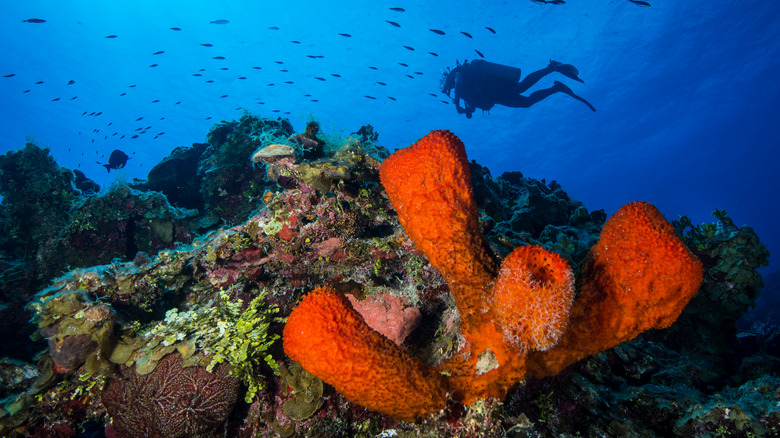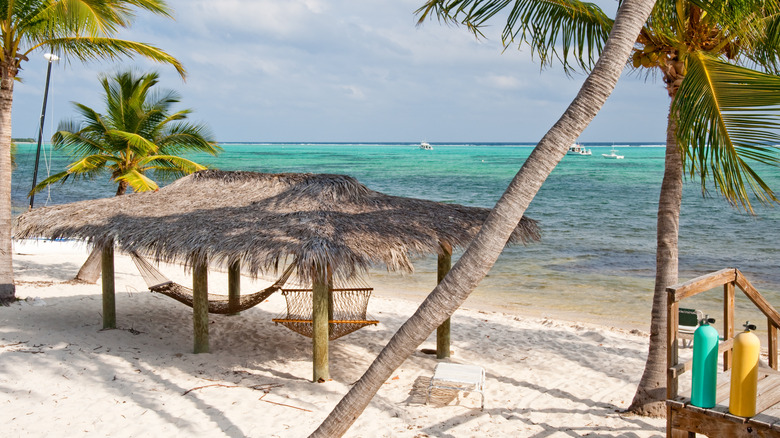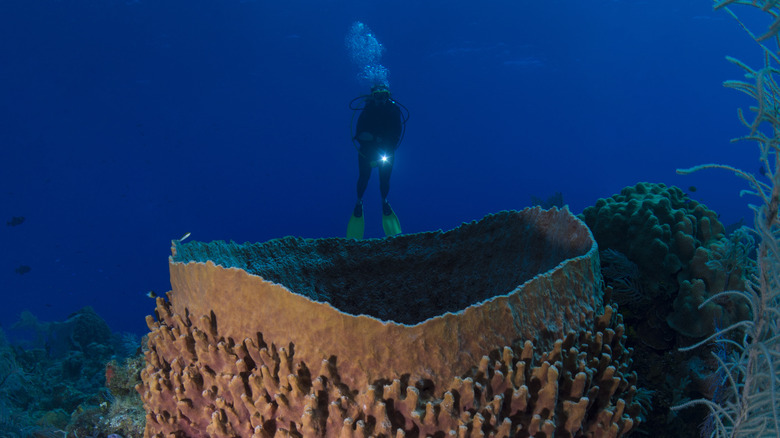One Of The Best Dive Sites In The World Is At This Gorgeous Caribbean Island
As wide as a mile and over 5,000 feet deep, Little Cayman Island's Bloody Bay Wall is like an undersea high-rise condominium inhabited by every species of reef life imaginable. And thanks to its protected, current-free waters, high visibility, and easy accessibility, this vertical seascape is also one of the world's most photographed dive destinations. Picture gently wafting fans of coral, Dr. Seuss-like forests of orange and blue tube sponges, and surreal clusters of elephant ears, all of it technicolor by day and shot through with eerie bioluminescence by night.
Named for long-ago pirate skirmishes, Bloody Bay is, in fact, a particularly peaceable kingdom, where trips are possible year-round, although best in summer and fall. The show starts as shallow as 20-30 feet and continues on down as schools of colorful angelfish dart about, and if you listen carefully, you can hear the crunch of parrot fish munching coral with their beaks. Meanwhile, eagle rays, hawksbill sea turtles, and the occasional nurse shark cruise the seafood buffet.
The Bloody Bay Wall is a dive destination for true connoisseurs
While Grand Cayman island is a world-class tourist destination bustling with fine dining, five-star resorts, and activities galore — including world-class diving — Little Cayman island, which boasts a year-round population of under 200, is a dedicated diver's paradise known as "the Mecca of the Caribbean." The island's few resorts all cater to underwater explorers: You can choose eco-resort amenities at the Clearly Cayman Dive Resorts or go old school in a luxurious beachfront bungalow at the island's original resort, the 1958 Southern Cross Club. And if you're really hardcore, you can skip shore life entirely and visit aboard a liveaboard dive boat, like the highly rated Cayman Aggressor IV.
Just as you'll find dedicated mountaineers hanging out at Mount Everest Base Camp, you'll find divers hanging out in Little Cayman's 10 square miles of paradise. Unlike Everest, however, Bloody Bay is a welcoming environment for adventurers of all abilities. Little Cayman Island's crown jewel, Bloody Bay Marine Park, offers plenty of beginner-friendly diving due to its calm, protected waters and the opportunity to reach splendid scenery at relatively shallow dive depths. And while diving is the main attraction, you'll also find beaches, snorkling bays, and picturesque shorelines for bicycling along while you decompress — just watch out for iguanas crossing the road.
The Bloody Bay Wall is full of bucket list sights
One exotic species you can only find at the Bloody Bay Wall is the endangered Nassau Grouper, a brown and white striped cartoon character of a fish known for their bold curiosity and photo-friendly, interactive antics — they seem to want to pose with divers the way Minnie and Mickey pose with visitors at Disney World. For a once-in-a-lifetime experience, time your visit for dusk on a full moon in the new year to see these rare creatures put on a glorious twilight show as they spawn en masse.
No less impressive is the Giant Barrel Sponge, sometimes known as the "Redwood of the Reef" because of its prodigious size and long lifespan. These sponges can grow to be up to 6 feet wide and 8 feet tall and can live for hundreds of years.
If your tastes are a little less Disney and a little more early Spielberg, the Cayman Islands are home to 17 species of shark, and Little Cayman offers some of the best odds for spotting sharks in the wild, especially near the Jackson Wall, also part of the Bloody Bay Marine Park. Divers on a week-long vacation often report multiple sightings. You are most likely to find benign nurse sharks in the shallows, and Caribbean reef sharks and hammerheads are common, too — here are some tips for swimming with sharks while snorkeling or scuba diving.


